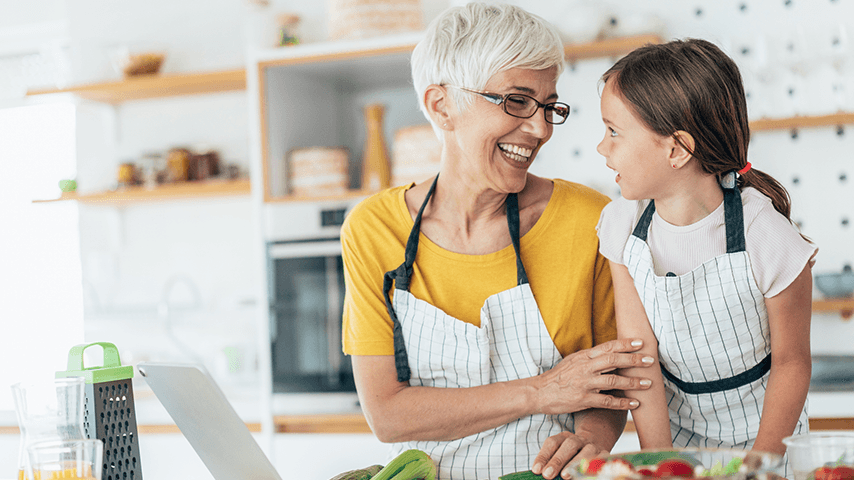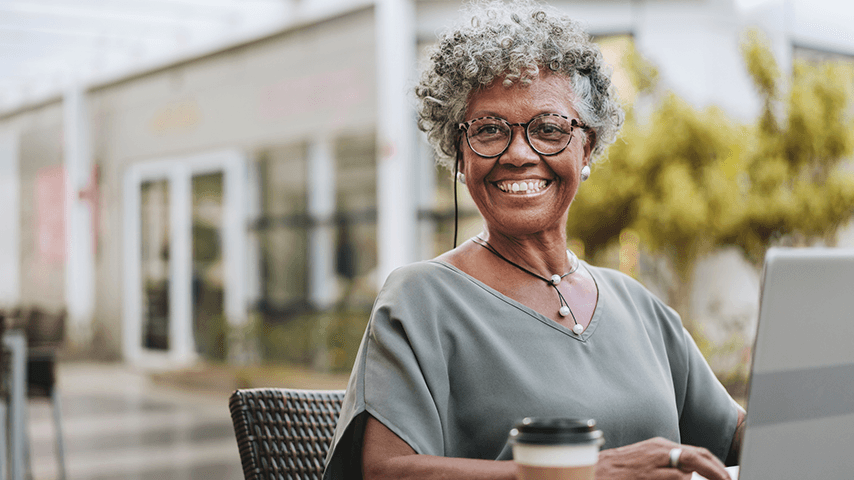
Related Topics
Cooking and entertaining helps maintain independence and enhances connections with others through the shared joy of food. Enjoying frequent meals with family and friends, especially as we age, can vastly reduce isolation and loneliness.
Although preparing meals creates unique challenges for adults with vision loss, adaptive techniques, equipment, and safety practices can ensure that meals are prepared safely and confidently.
Meal planning and grocery shopping for enhanced independence
Vision rehabilitation training provides a broad range of strategies and resources to make shopping more accessible and enjoyable for those with vision loss.
Meals can be planned for the entire week or more, with a comprehensive shopping list organized by aisle/area to reduce the number of shopping trips. Accessible tools, such as a voice assistant, Braille notetaker, or smartphone app, can help create your shopping list.
Shopping at off-peak times helps you navigate the aisles more efficiently and reduces check-out time. Where possible, you can choose items with more accessible packaging, such as pull tabs, resealable bags, single-use options, or premeasured ingredients.
Technology can also assist during shopping trips, with apps like Be My Eyes and WeAssist that can connect you with sighted volunteers to help identify items, read labels or provide other support through video on your smartphone. Be My Eyes' new AI feature helps identify items audibly using your smartphone camera. A handheld barcode scanner and barcode apps also help confirm product information, including nutritional information and other details.
Some of us have a family member or friend who can assist us with shopping. Did you know that some stores, like Walmart and other grocery chains, offer assistance for people with vision loss? Call to see if your store can provide a team member to guide you through the aisles to locate the items on your list, assist you with your shopping cart, or give you a store tour. You can also contact your local vision rehabilitation agency to see if they can provide a volunteer to assist with shopping.
An increasingly large number of grocery stores help us avoid navigating the physical store entirely through online shopping apps accessed from the comfort of our homes. Many apps can be accessed using screen readers and home assistants; some offer voice search options. Depending on the store, various pickup options may be available, including in-store or curbside pickup and home delivery.
Organizing and labeling items for safety
Vision loss can make it difficult, if not impossible, to differentiate items and settings on appliances. For those with low vision, kitchen contrast and lighting can make navigating the kitchen and other areas of your home easier. For example, if you have dark countertops, use light-colored cutting boards and contrasting mats under small appliances. Use dark cutting boards when prepping light-colored foods.
Braille or large-print labels, tactile markers, and audio labeling systems help label kitchen appliances and dials or buttons controlling settings and speeds. Some newer appliances offer voice-activated controls for hands-free operation.
Store kitchen utensils and tools by type and in designated drawers or cabinets. For example, store cutting tools together to ensure proper care when using sharp items in that area.
Organize and track grocery and pantry items by consistently storing food, spices, and other items in the same place, and consider using different types and sizes of containers. Braille or large-print labels help quickly identify items as needed and maximize safety. As with shopping, apps like Be My Eyes' new AI feature can help you identify items on the shelf, refrigerator, or countertop.
Maximizing kitchen safety
The kitchen poses safety risks for all, and safety is paramount for people with vision loss, given the large number of hot appliances and sharp objects.
- Keeping your work area organized and clutter-free, with a designated place for tools and ingredients, can reduce accidents.
- Using voice commands with home assistants or audible/tactile timers can help manage cooking times, reducing the risk of overcooking or burning food.
- Safety gloves, oven mitts that cover the forearm, and heat-resistant mats can reduce the risk of burns.
- Turning pot handles towards the back or side of the stove during cooking reduces the risk of spills and scalding from hot liquids and food.
- All homes should have smoke and carbon monoxide detectors, and versions with auditory alerts are now available. When you maintain a mental map of your kitchen, be sure to know where the fire extinguisher or fire blanket are located.
Accessible cooking strategies
Food prep and cooking require adapted techniques for adults with vision loss. For example:
- Tactile, large-print, and Braille measuring spoons and cups help measure various ingredients. Talking measuring cups and jugs, as well as spice auto-measuring carousels, are also available.
- Using adaptive tools like specialized choppers, knives, and finger guards to prep food reduces injuries during cutting.
- Place cutting boards on non-skid mats and use pot stabilizers to keep pots in place while stirring. Use different cutting boards, including boards of contrasting colors, to reduce the risk of cross-contamination when prepping food.
- Use liquid level indicators and pour liquids over the sink to avoid spills and contamination of your workspace
- A wide array of talking appliances and food prep devices are now available, including smart ovens, microwaves, and thermometers that take the guesswork out of cooking foods to safe temperature levels. Smart home features also provide an increasing range of voice-activated or app-controlled options and features.
- Accessible cookbooks are available in Braille and can be accessed online with a screen reader or with auditory instructions with a smart device.
- Single-pot meals make cooking easier by minimizing the number of pots and pans used during meal prep and significantly reducing clean-up time. Varied and delicious single-pot and casserole recipes are available for stovetop or traditional oven use, slow cookers, and more.
Enjoying wonderful meals together can be some of life’s most precious moments. By maintaining a highly organized kitchen, using adaptive tools, labeling, and shopping and cooking strategies, adults with vision loss can safely and independently create meals for themselves and share them with family and friends.
Local vision rehabilitation agencies offer specialized training to help with shopping, kitchen labeling, food storage, meal prep. A vision rehabilitation specialist can visit your home to assist with kitchen organization and labeling appliances, ingredients, and more. Specific recommendations are provided for adaptive tools and aids. In many cases, agencies offer no-cost training and, depending on the scope of vision loss, may secure adaptive aids and equipment at no cost. Access a list of vision rehabilitation agencies. You can also visit Time to Be Bold to locate local vision rehabilitation services and other vital resources. Call the APH hotline to receive support and practical coping strategies for everyday tasks, join remote discussion groups, and access free online resources at the APH Connect Center and VisionAware. You can purchase adaptive kitchen, cooking, organization items and more online, including specialized online stores offered by a VisionServe Alliance member in your area, Walmart.com, Amazon.com, and others. You can download Be My Eyes, and WeAssist on your device for added support.
Learn more about vision loss and vision rehabilitation through other articles in this series:
- Identifying Undiagnosed Vision Loss
- Common Age-Related Eye Diseases: What to Know and What You Can Do
- What Independent Living Skills Help People Living With Vision Loss?
- Helping People with Blindness and Vision Loss Continue to Participate in Everyday Activities
- How Assistive Technology and Adaptive Equipment Help People Living with Vision Loss
- How Orientation and Mobility Training Can Improve Quality of Life For People Living With Vision Loss
- What Is Accessibility and Why Is It Important for People with Vision Loss?
- Safety Tips for Older Adults Living with Vision Loss




